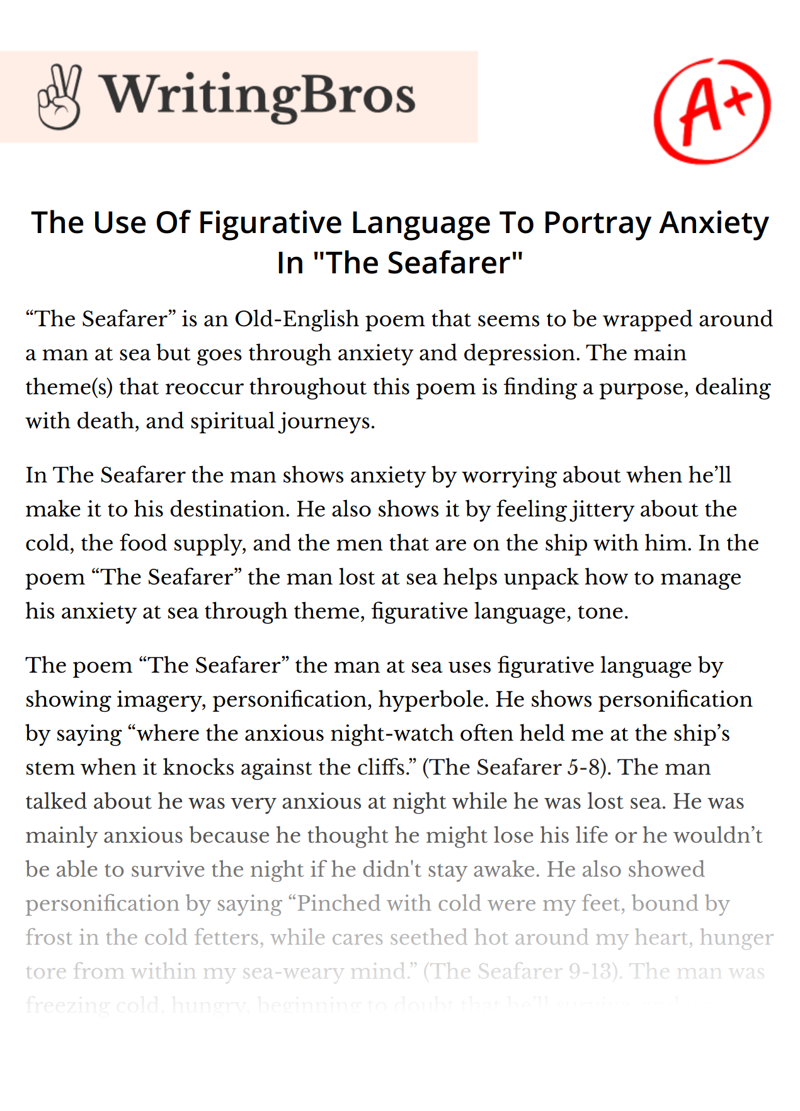The Use Of Figurative Language To Portray Anxiety In "The Seafarer"

“The Seafarer” is an Old-English poem that seems to be wrapped around a man at sea but goes through anxiety and depression. The main theme(s) that reoccur throughout this poem is finding a purpose, dealing with death, and spiritual journeys.
In The Seafarer the man shows anxiety by worrying about when he’ll make it to his destination. He also shows it by feeling jittery about the cold, the food supply, and the men that are on the ship with him. In the poem “The Seafarer” the man lost at sea helps unpack how to manage his anxiety at sea through theme, figurative language, tone.
The poem “The Seafarer” the man at sea uses figurative language by showing imagery, personification, hyperbole. He shows personification by saying “where the anxious night-watch often held me at the ship’s stem when it knocks against the cliffs.” (The Seafarer 5-8). The man talked about he was very anxious at night while he was lost sea. He was mainly anxious because he thought he might lose his life or he wouldn’t be able to survive the night if he didn't stay awake. He also showed personification by saying “Pinched with cold were my feet, bound by frost in the cold fetters, while cares seethed hot around my heart, hunger tore from within my sea-weary mind.” (The Seafarer 9-13). The man was freezing cold, hungry, beginning to doubt that he’ll survive, and was beginning to really fear for his life to at one point he really did not consider God.
Another thing the man showed in this poem was tone, he showed anxiety and depression, fear, then hope. The man showed anxiety and depression by always looking down on things and really not having hope on his side because he was cold, hungry, and lost. While he was lost at sea he began to really just think his life was over and that he would basically never survive the seas. He showed a lot of anxiety by not sleeping so he was also really sleep deprived to make sure nothing would happen and the thought of something happening to him or his crew members sent him into a frenzy and he really was not able to sleep.
He showed this by saying “dewy-feathered - no sheltering family could bring consolation to my abandoned soul.” (The Seafarer 25-26). He showed fear by having many restless nights of staying up to make sure nothing happens to him and to the people he’s on the ship with. He then had a change of heart and gain hope because of God he then saw that God was protecting him. He said, “nor so loyal to his lord, that he never has sorrow at his seafaring when he sees what the Lord has in store for him.” (The Seafarer 41-43). The man became more hopeful and learned that God was right by him.
The last but not least thing the man showed was a theme and how he learned a life lesson to take with him. He soon learned that he did not need to worry so much and that he could roam the world and feel the actual joys of it instead of worrying about the worst. He began to feel real joy and did not have to depend on anyone for it. He realized God gave him the gift to enjoy the thing he loves to do with being sad and anxious about it.
The only thing is he did not believe and life rushed past him and he died. God warned him but he just could not believe that a spirit being such as God could bear him happiness. In the poem it says “A man must steer a strong mind and keep it stable, steadfast in its promises, pure in its ways” This poem states that if he had a strong head on his shoulders he would’ve wandered the world being happy but instead he doubted and died.
In conclusion, the seafarer in the poem was the man and how he was so depressed and lonely while being lost at sea. Not only was he lost at sea he found God and even began to doubt him. He learned in this poem don't worry so much, don't put so much on your shoulders you're not happy within yourself and soon you'll never find happiness and die alone and still unhappy without anyone really caring. It's okay too put your problems in God's hands and let him help you relax.
Cite this Essay
To export a reference to this article please select a referencing style below

